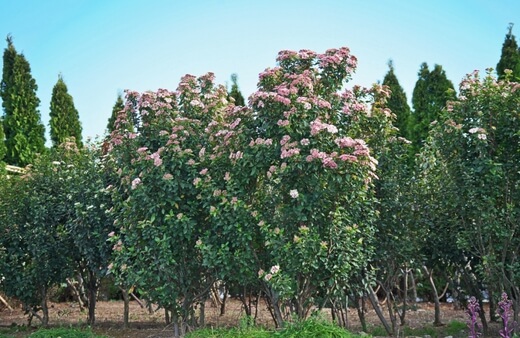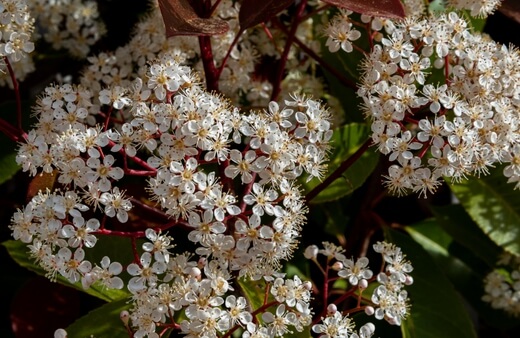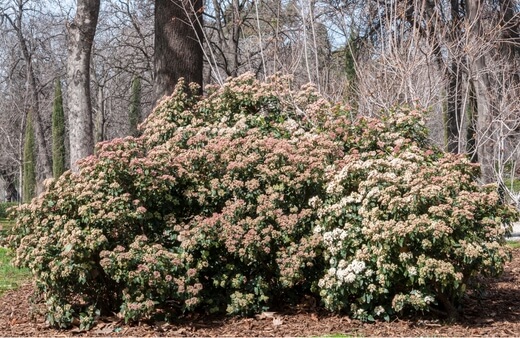Viburnum tinus is a shrub that is always good looking. From evergreen leaves, to pink buds, white flowers, and bright blue fruit, it’s a visual delight all year round. In our how to grow and care guide, we’ll introduce you to Laurustinus in more detail.
More...

Family: | Adoxaceae |
|---|---|
Genus: | Viburnum |
Species: | V. tinus |
Common Names: | Laurustinus |
Origin: | Native to the Mediterranean region of Europe and North Africa |
Location: | Outdoor |
Type: | Shrub |
Growth: | Up to 3 metres tall and wide |
Sun requirements: | Part shade, full shade, full sun |
Foliage Colour: | Green |
Flower Colour: | White |
Flowering: | Late winter to spring |
Fruit: | Dark blue/black, not edible |
Maintenance level: | Low |
Poisonous for pets: | No |
Introducing Viburnum tinus

Viburnum tinus, also known as Laurustinus, is related to the honeysuckle family. This evergreen shrub can reach a height and spread of up to 3 metres and grows quickly. The leaves are a shiny dark green colour which contrast beautifully against the pink flower buds that pop up at the end of winter and into spring. These pretty buds then bloom into small white flowers. After the flowers come blueberries into autumn.
Laurustinus is native to the Mediterranean part of Europe and North Africa. They work well in coastal areas as the shrub can handle salt spray. You are able to grow Viburnum tinus easily in a pot if preferable and there are a few different cultivars to choose from.
The lovely flowers of the Laurustinus attract bees, birds and butterflies with their delightful nectar and pollen. Of course the birds also enjoy the fruit and seeds of the shrub, and depending on the size of the plant, you might even find some nesting in the branches.
In terms of garden use, Viburnum tinus works well as a border plant, but is equally great as a hedge or screen. You can simply prune to shape. A garden screen has many benefits including protection from the wind and also buffering against noise.
Commonly grown cultivars include:
- Viburnum tinus ‘Bewley's Variegated’ - this variety has green leaves with yellow edges. It grows to about 1.5 metres.
- Viburnum tinus ‘Spring Bouquet’ or ‘Compactum’ – this is a dwarf form and popular variety with pink flowers.
- Viburnum tinus ‘Robustum’ or Roundleaf Laurustinus – this variety has big leaves that are about 10 cm in size and pink flowers.
Growing Viburnum tinus in Australia

In its natural habitat, the Viburnum tinus shrub grows in wooded areas and often close to the sea. This shrub makes life really easy for any gardener as it’s versatile in terms of the growing conditions it needs.
Viburnum tinus Propagation
Viburnum tinus can be propagated using a semi-hardwood cutting. The best time to do this is summer. Be sure to use a sterile and sharp tool to take the cuttings and each piece should be between 10 and 15cm. Try to take your cuttings in the morning. Once you have your pieces, you can remove the leaves from the lower third of the stem.
Create a mixture of peat and perlite and give it enough water to ensure the growing mixture is moist. You can use rooting hormone to help the rooting process but it’s not a must. When you are ready to plant the cutting into the mixture, try and make sure that a third or up to half of the stem length is covered.
Once the cuttings are planted, you can cover the container with plastic and put it in a spot that has indirect light. You’ll need to make sure that the planting mixture stays moist and you can mist the cuttings as well to maintain moisture levels.
After 4 weeks have passed, you can gently pull on the cuttings to check if rooting has taken place.
How to Care for Viburnum tinus
Sunlight
Laurustinus can be planted in full sun or part shade.
Climate
Viburnum tinus enjoys a Mediterranean climate. It does naturally grow close to the ocean and can manage strong wind, but is generally used to a more protected wood area. Laurustinus doesn’t enjoy high humidity but is frost hardy.
Watering
The shrub needs regular watering in summer if you live in a hot and dry region. Viburnum tinus can handle very dry conditions but ultimately if it gets a moderate amount of water, it will be in its best shape.

Soil
Viburnum tinus needs a well-draining soil and will do well with a sandy or chalky soil. It can however adjust to many garden soils so loam or a heavy clay is also fine. The main thing is to make sure that the soil doesn’t become waterlogged. Laurustinus can handle slightly alkaline to acidic soils.
Pruning
Pruning of your Laurustinus is not essential. They generally find their own lovely shape if left alone. If you are needing to prune your shrub to maintain a hedge or screen, rather clip the Viburnum tinus with secateurs.
You can also keep an eye out for any damaged or diseased shrub that needs to be pruned out. We recommend doing your pruning at the end of winter or beginning of spring.
Fertiliser
You can add compost to the soil when you first plant your Viburnum tinus to give it a head start. Add mulch to the shrub in spring along with a balanced fertiliser to keep it happy.
Laurustinus Pests and Diseases to Look Out For
Aphids
Aphids are a common pest that can affect your Viburnum tinus. You can use an insecticidal soap or horticultural oil for treatment. You’ll need to make sure to cover the leaves well with the treatment and make sure you get to both sides of the leaf surface. You’ll need to do at least 3 applications and can space them about a week apart.
You can also use a spray bottle with a mixture of dish soap and water and be sure to get on the underneath side of the leaves as this is usually where you would find the eggs and larvae. The soap helps to break down the aphid’s protective layer and kills them off.
Refer to our guide to know more about aphids and how to deal with them organically.
Honey fungus
Honey fungus belongs to a group of fungi from the Armillaria genus. It works underground where it attacks and kills off the roots of plants. Signs above the ground surface could be that parts of the plant start to die over a period of time.
The shrub might have smaller leaves that look pale. In some cases the shrub might not flower at all or it can over produce flowers and fruit but then dies afterwards. Unfortunately there is no treatment for honey fungus and you would need to get rid of the infected shrub and destroy it, making sure to get rid of roots and all.
Leaf spot
Leaf spots on Viburnum tinus often have a strange shape and you might notice that the spot looks dry and sunken in. The spots tend to start out small and grow over time, and sometimes flow into each other. The colour of the spots is from red to a grey brown.
Eventually the leaves might start falling off. The actual fungal disease is caused by a type of algae that likes moisture and shade. For treatment, we recommend getting rid of any infected leaves and then prune the plant in any parts that are overgrown to help with air circulation.
You can also apply a fungicide every 2 weeks until it has cleared up. If you’re looking to treat leaf spot with a natural remedy, you can spray your shrub monthly with garlic extract or a copper based spray. These both work to halt the fungal growth.
Viburnum beetle
As the name suggests, Viburnum tinus is a much loved snack of the Viburnum beetle. The larvae that arrive in spring can do some great damage especially if there is a large infestation, and the adult beetles then finish off the leaves in summer. The leaves start to look like lace with all the holes.
The leaves affected by the beetle usually discolour, and the holes made by the pest are brown and dried up. A Viburnum tinus that has been attacked by a Viburnum beetle can give off a horrible smell when the leaves get wet.
You can try and get rid of some of the larvae by hand where possible. Another solution is to encourage birds and predatory beetles to come and visit as they will control the larvae and adult beetles.
Viburnum tinus Frequently Asked Questions

How long does it take for Viburnum tinus to reach its full size?
It can take between 10 and 20 years for the shrub to achieve its complete height and spread.
Is the fruit of the Viburnum tinus edible?
This is not recommended as the fruit causes an upset tummy.
What are some of the uses of Viburnum tinus?
The leaves of the shrub can be infused to create a tonic to treat fever. The fruit of Viburnum tinus is useful in treating constipation, and a tincture has been created to help treat depression.
How long does Viburnum tinuslive for?
The shrub is considered long living with a lifespan between 50 and 150 years.
Does Viburnum tinus have deep roots?
The root system of the shrub can grow to a depth of around 45cm but the main roots that take in nutrients are found closer to the top of the soil.
What is the best fertiliser for Viburnum tinus?
We recommend using mulch that contains manure or fish fertilisers. You can also add bone meal when you first plant the shrub to assist new development.
Be sure to check out our main Viburnum article to discover more varieties to grow in your garden.
Also, sign up for our newsletter for more gardening advice, tips, and plant profiles.
Wrapping Up Our Viburnum tinus Growing and Care Guide
Laurustinus is a wonderful shrub to consider for your garden. Hardy and low maintenance, the shrub is long living and offers up natural beauty throughout the seasons. It’s equally happy whether pot bound or planted in the garden, and you can use it as a feature plant or screen. We’re giving Viburnum tinus our green thumbs up!
Published on March 18, 2023 by Maisie Blevins
Last Updated on February 23, 2024




